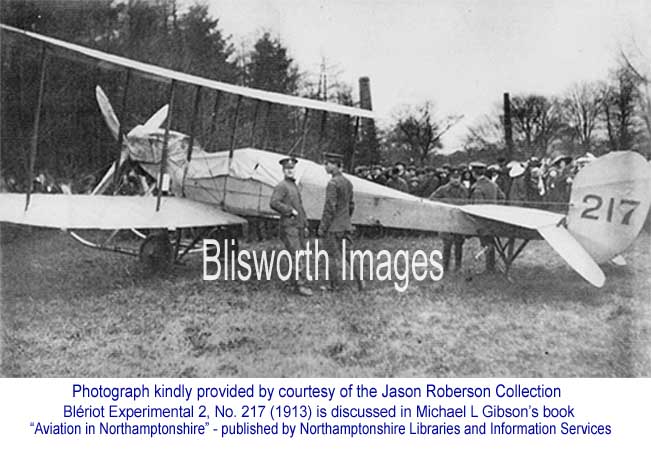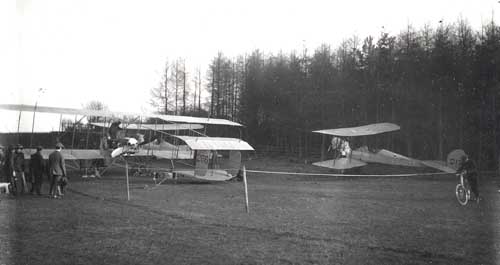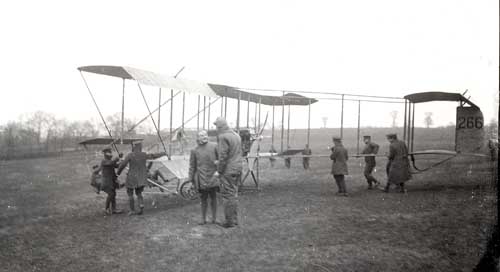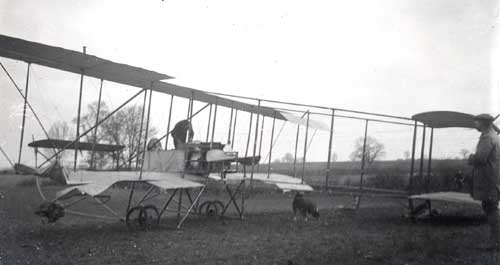The Great War (WWI) seen through the School Log book
Mr. Arthur Green, Head Teacher at Blisworth School was a steady man - so
steady that nothing appears in the log of any village mood or tragedy in the
span of the war. He reports his day to day successes and problems in a
business-like manner. Many of his entries, which have been copied verbatim (with
a few exceptions) are food for thought indeed.
Feb 13, 1913 - "School attendance adversely affected by anticipated
flying machines in the area"
Feb 17, 1913
- "10 children
fetched out by parents to see the flying machines - school dismissed early"
Feb 20, 1913
- "School allowed
out this morning, 9.50 to 10.10, to view aeroplanes flying over from Tiffield"
Sep 24, 1913
- "Work will cease
this morning at 11.30 and children will be taken outside and placed to see the
King pass" [then presumably the pm] " .. attendance poor owing to army
manoeuvres being carried out nearby, also the fleet of aeroplanes having their
headquarters close to the village".
[ Please note: there is a short article below on the "flying machines" ]
Sep 24, 1914 - "Gardening notebooks
forwarded as requested to the Education Office"
Nov 4, 1914 - "We have a request by local Belgian Relief Committee
to assist them by organising a weekly collection from the children. To enlist
their sympathy, the purpose of this appeal has today been explained to
them"
Nov 5, 1914 - "The chairman of the managers called and checked the
Special Subject Gardening Register"
Jun 24, 1915 - "Playtime was extended to 11.20 this morning - mimic
warfare was being carried on around the school by a squadron of yeomanry and
work was impossible".
Sep 16, 1915 - "As yesterday afternoon, truant gleaning is again
adversely affecting the attendance"
Sep 28, 1915 - "Re. the Cheap Food Campaign inaugurated by the Local
Education Authority, Miss Oughton has arranged to attend the demonstration and
give the cookery lessons at this school"
Dec 1, 1915 - "The children have today contributed 15 shillings
towards the Overseas Club Fund for Christmas comforts for sailors and
soldiers"
Dec 10, 1915 - "Owing to lack of apparatus it has not been possible
to start the cookery course in connection with LEA's Economical Food
Campaign"
Mar 6, 1916 - "Letter of thanks received for the weekly gift of eggs
for the hospitals for wounded soldiers"
May 22, 1916 - "The new summertime came into force today - no child
was behind time"
Jul 17, 1916 - "Head Teacher has been notified from the Barracks
Northampton that his 'Notice of Call Up" has been temporarily
cancelled"
Nov 10, 1916 - "Three of the managers came into the school to
address the children in simple language on the usefulness of joining the School
War Savings Association"
Nov 15, 1916 - "War Savings started with 54 members, half the
school, and £1 - 7 - 11d contributed" [to whom?]
May 22, 1917 - "Geography will include the dangers of importation of
food, the need for economy and avoidance of waste. The oral lessons will be
written and taken home to parents"
Sep 18, 1917 - "No school this afternoon - children gathering
blackberries as suggested by a circular from the LEA"
Oct 23, 1917 - " .. the blackberry picking ceased. The children have
gathered altogether 5 cwt 2 qrs 5 lbs."
Feb 21, 1919 - "An arithmetic lesson today on the value of
decimals" [Ed. added for its appeal!]
Aug 1, 1919 - "School breaks up today - one week extra holiday for
the Peace Celebrations - the latter being granted at the request of His Majesty
the King"
et seq. much is said about economies for years to follow.
________________________________________________________________________
F L Y I N G M A C H I N E S A T
T I F F I E L D
 The following information has been obtained from Michael Gibson's book.
In 1912 the Army and Navy established a Military Wing with HQ at Farnborough and
in 1913 a base was established at Montrose near Aberdeen. Squadron No.2
was to be transferred to Montrose for both training and as an experiment in
mobility. The transfer was not well organised and Capt. JWH Becke was
obliged to land near Blakesley on Feb 18, 1913 for more fuel before finally
landing at Tiffield. The photograph shows his aeroplane - a B.E.2a number
217 under guard. He was joined by three more in the next three days.
Poor weather delayed their departure northwards. Local residents were able
to see more Army flyers in the following months. Michael Gibson also
details the visit made by George V in order to inspect Army manoeuvres in the
county.
The following information has been obtained from Michael Gibson's book.
In 1912 the Army and Navy established a Military Wing with HQ at Farnborough and
in 1913 a base was established at Montrose near Aberdeen. Squadron No.2
was to be transferred to Montrose for both training and as an experiment in
mobility. The transfer was not well organised and Capt. JWH Becke was
obliged to land near Blakesley on Feb 18, 1913 for more fuel before finally
landing at Tiffield. The photograph shows his aeroplane - a B.E.2a number
217 under guard. He was joined by three more in the next three days.
Poor weather delayed their departure northwards. Local residents were able
to see more Army flyers in the following months. Michael Gibson also
details the visit made by George V in order to inspect Army manoeuvres in the
county.
Further information garnered from a variety of websites: The BE stood for
'Blériot Experimental' although M. Blériot had
nothing to do with this aircraft which was in fact manufactured by de Havilland
from 1912. The reference to Blériot arises from an
early use of a "tractor" propeller rather than a pusher
propeller. The BE2 was an extremely stable machine used for reconnaissance and bombing, carrying up to 100 lb bombs. It actually took part in bombing raids. With the increase in counter-air activities in early 1915, the type was soon relegated to second line duties
such as training.
It has been pointed out that the chimney stacks in the background of this
picture are
part of some brickworks on the Towcester side of the village of Tiffield.
From the extract below, it seems that the trip north from Farnborough was
marked by other landings! This perhaps enabled Blisworth people to be
tipped-off on February 13th and again on the 17th. Mr. Sunderland, Northampton,
gave a talk on the preparations for an anticipated WWI in 1913-14. In addition
to much activity as noted by the school children over flying machines, there
were manoeuvres by soldiers heading north from Alderton, via Easton Neston, to
Towcester going on with airmen attempting to spy on them. King George arrived on
horseback at the Elm and was questioned by a few villagers as to what was going
on - "I am watching my soldiers" he replied.

The 1912 - 13 activity by what was essentially the beginnings of the RAF,
were preceded by aviation over the County in 1910. Note the Northampton Independent
article referred to elsewhere.
MORE PICTURES
Further photographs kindly provided by Peter Butcher, Gayton. They
indicate that at least
two types were used at Tiffield. The second sort, shown below uses a
"pusher" propeller
and, at present, its type is not known.



 The following information has been obtained from Michael Gibson's book.
In 1912 the Army and Navy established a Military Wing with HQ at Farnborough and
in 1913 a base was established at Montrose near Aberdeen. Squadron No.2
was to be transferred to Montrose for both training and as an experiment in
mobility. The transfer was not well organised and Capt. JWH Becke was
obliged to land near Blakesley on Feb 18, 1913 for more fuel before finally
landing at Tiffield. The photograph shows his aeroplane - a B.E.2a number
217 under guard. He was joined by three more in the next three days.
Poor weather delayed their departure northwards. Local residents were able
to see more Army flyers in the following months. Michael Gibson also
details the visit made by George V in order to inspect Army manoeuvres in the
county.
The following information has been obtained from Michael Gibson's book.
In 1912 the Army and Navy established a Military Wing with HQ at Farnborough and
in 1913 a base was established at Montrose near Aberdeen. Squadron No.2
was to be transferred to Montrose for both training and as an experiment in
mobility. The transfer was not well organised and Capt. JWH Becke was
obliged to land near Blakesley on Feb 18, 1913 for more fuel before finally
landing at Tiffield. The photograph shows his aeroplane - a B.E.2a number
217 under guard. He was joined by three more in the next three days.
Poor weather delayed their departure northwards. Local residents were able
to see more Army flyers in the following months. Michael Gibson also
details the visit made by George V in order to inspect Army manoeuvres in the
county.



